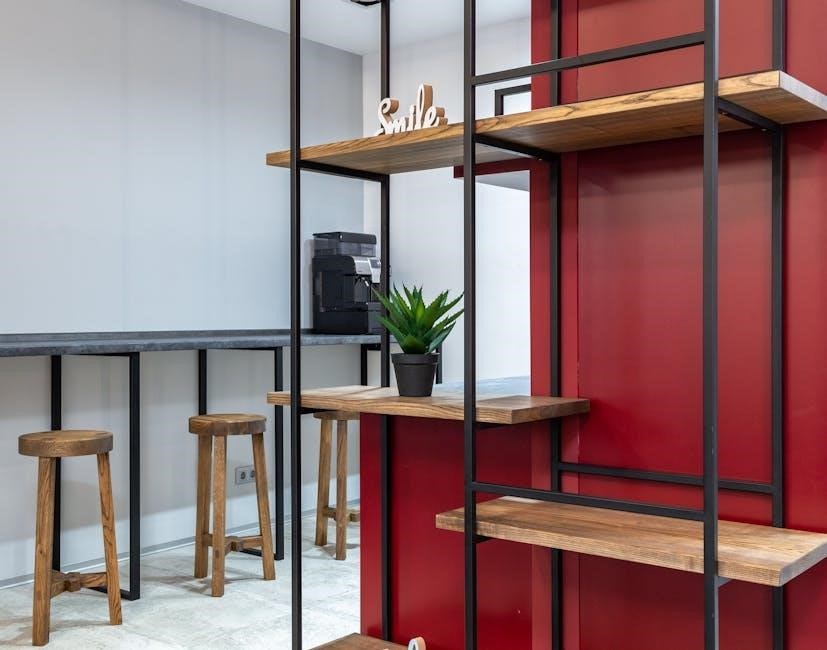
counter stool height guide
Choosing the right stool height for your counter or bar is essential for comfort and functionality․ Understanding standard heights, measuring accurately, and considering clearance ensures a perfect fit for any space․
Understanding Counter and Bar Heights
Counter and bar heights vary, with counters typically around 36 inches and bars at 40-42 inches․ Understanding these measurements is key to selecting stools that fit seamlessly and comfortably․
Counter vs․ Bar Heights
A counter typically stands at around 36 inches (91 cm), while a bar is taller, ranging from 40 to 42 inches (102-107 cm)․ This difference significantly impacts stool height selection․ Counter stools are designed for lower surfaces, usually measuring 24-27 inches (61-69 cm), while bar stools are taller, ranging from 28-33 inches (71-84 cm)․ The height difference ensures proper alignment and comfort for users․ When pairing stools with counters or bars, it’s essential to consider the specific height of the surface to maintain ergonomic balance․ For instance, a 36-inch counter pairs well with a 24-inch stool, while a 42-inch bar requires a 29-30 inch stool․ Clearance between the stool seat and the counter or bar should also be maintained, typically 10-12 inches, to ensure comfort and ease of movement․ This distinction between counter and bar heights is crucial for creating a functional and comfortable seating arrangement․
Impact of Counter Thickness
Counter thickness plays a crucial role in determining the ideal stool height․ A thicker countertop can reduce the available legroom and affect the overall comfort of the seating․ For instance, a 44-inch counter may require a stool with a seat height of 32-34 inches to accommodate the average countertop thickness․ This measurement ensures there is enough space between the stool seat and the counter, typically 10-12 inches, for comfortable seating․ Thicker counters may necessitate taller stools to maintain proper ergonomics, while thinner counters might allow for slightly shorter stools․ It’s important to measure both the counter height and its thickness to select stools that provide optimal comfort and functionality․ Ignoring counter thickness can lead to poor ergonomic outcomes, such as insufficient legroom or a stool that feels too high or too low․ Balancing these factors ensures a seamless integration of stools with any countertop․
Standard Counter Height and Stool Height
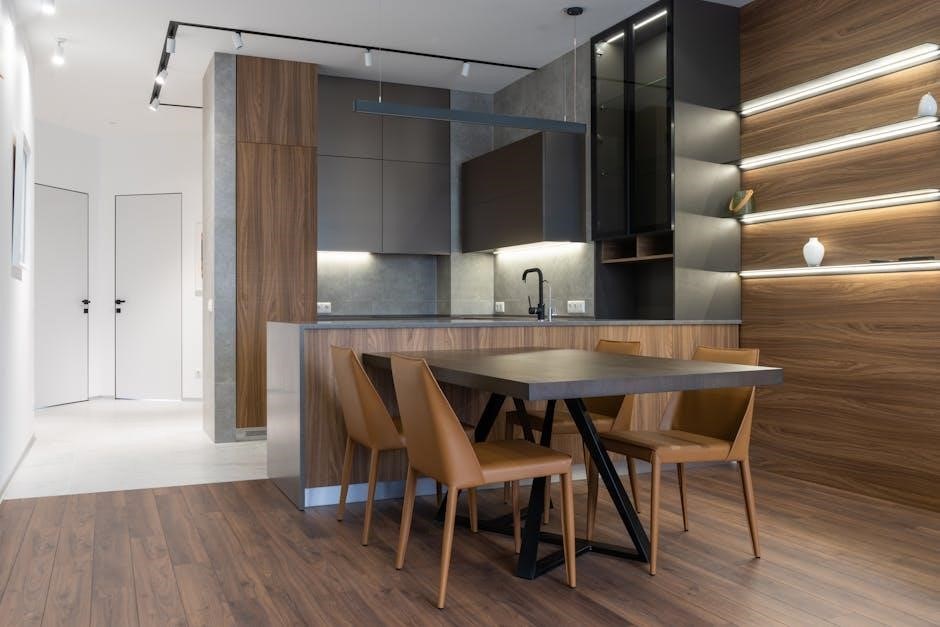
Standard counter heights typically range between 36 and 42 inches, with stools varying from 24 to 33 inches to ensure proper ergonomic alignment and comfort․
Average Counter Height
The average counter height typically stands at 36 inches (91 cm) above the floor, providing a comfortable workspace for most users․ This standard measurement ensures ergonomic alignment and ease of use for everyday activities․ For countertops at this height, stools with seats ranging from 24 to 27 inches (61 to 69 cm) are generally recommended to maintain proper posture and comfort․ However, bar-height counters, which are taller at around 42 inches (107 cm), require stools with higher seats, typically between 29 and 32 inches (74 to 81 cm)․ The thickness of the countertop also plays a role, as it affects the overall height and the clearance needed between the stool seat and the counter․ Ensuring the right fit is crucial for both functionality and user comfort in any kitchen or bar setting․
Standard Stool Height Range
Stool heights are designed to complement various counter and bar configurations, with a standard range of 24 to 33 inches (61 to 84 cm) from the floor to the seat․ Counter-height stools typically fall between 24 and 26 inches (61 to 66 cm), making them ideal for 36-inch (91 cm) countertops․ Bar-height stools are taller, ranging from 28 to 30 inches (71 to 76 cm), suited for 42-inch (107 cm) bar counters․ Extra-tall stools, measuring up to 33 inches (84 cm), are used for higher surfaces or unique spaces․ The height should allow users to sit comfortably with their elbows at counter height and knees slightly below the countertop․ Proper ergonomic alignment ensures comfort and prevents strain․ Always consider the user’s height and the space’s functionality when selecting stools, as these factors significantly impact the overall experience․ A well-chosen stool height enhances both usability and aesthetics in any setting․
Counter vs․ Bar Stools
Counter stools and bar stools differ primarily in height and design, catering to distinct spaces․ Counter stools are shorter, typically ranging from 24 to 26 inches (61 to 66 cm), and are designed for standard kitchen counters or breakfast bars․ They often feature compact frames and ergonomic designs for everyday use․ Bar stools, on the other hand, are taller, usually between 28 and 30 inches (71 to 76 cm), and are meant for higher surfaces like pub bars or island counters․ Bar stools may include additional features like backrests or armrests for enhanced comfort in social settings․ The choice between the two depends on the height of the countertop and the intended use of the space․ Both styles are available in various materials, such as wood, metal, or upholstered options, allowing for customization to match interior decor․ Selecting the right type ensures functionality and aesthetic harmony in any room․

Factors Influencing Stool Height Choice
Key considerations include counter height, user comfort, and space availability․ Personal preference and design style also play significant roles in selecting the ideal stool height for any setting․
Relation to Counter Height
Stool height choice is directly influenced by the height of the counter or bar․ A general rule is to ensure the stool seat is 10–12 inches shorter than the counter to allow comfortable seating and legroom․ For standard counters, which are typically 36 inches tall, stools with a height of 24–26 inches are ideal․ Bar counters, usually 42 inches tall, pair best with stools ranging from 30–34 inches in height․ Proper alignment ensures users can sit comfortably without straining their arms or legs․ The gap between the stool seat and the counter should be around 10–12 inches to provide adequate thigh clearance․ This relationship ensures functionality and ergonomic comfort, making it a critical factor in selecting the right stool height for any space․
User Comfort and Ergonomics
User comfort and ergonomics are crucial when choosing the right counter stool height․ A stool that aligns with the user’s body promotes proper posture and reduces strain on the back and legs․ The seat depth and width should accommodate the user’s body comfortably, ensuring thighs are supported without pressure․ A backrest can enhance comfort by providing upper body support, especially for longer sitting periods․ Armrests are another feature that can aid in maintaining proper posture and making it easier to sit down or stand up․ Additionally, the stool’s height adjustability ensures it can cater to different users, maintaining optimal ergonomics․ The material’s thickness also plays a role, as thicker materials may offer better cushioning and comfort․ Prioritizing these ergonomic factors helps prevent long-term discomfort and potential health issues, ensuring a pleasant and healthy seating experience․
Space and Clearance Requirements
Space and clearance are essential considerations when selecting counter stools to ensure a functional and comfortable environment․ Adequate clearance between stools and surrounding surfaces, such as countertops, walls, or overhead cabinets, is critical․ Typically, 12 inches of overhead clearance is recommended to prevent obstruction and ensure easy movement․ Additionally, the space between stools should be at least 6 to 8 inches to avoid overcrowding and allow users to sit comfortably without feeling cramped․ Floor space is another factor, as stools should not obstruct pathways or create tripping hazards․ Measuring the total area where stools will be placed helps determine the optimal number of stools and their arrangement․ Proper spacing ensures a balanced layout, enhances accessibility, and maintains a safe and inviting atmosphere for users․
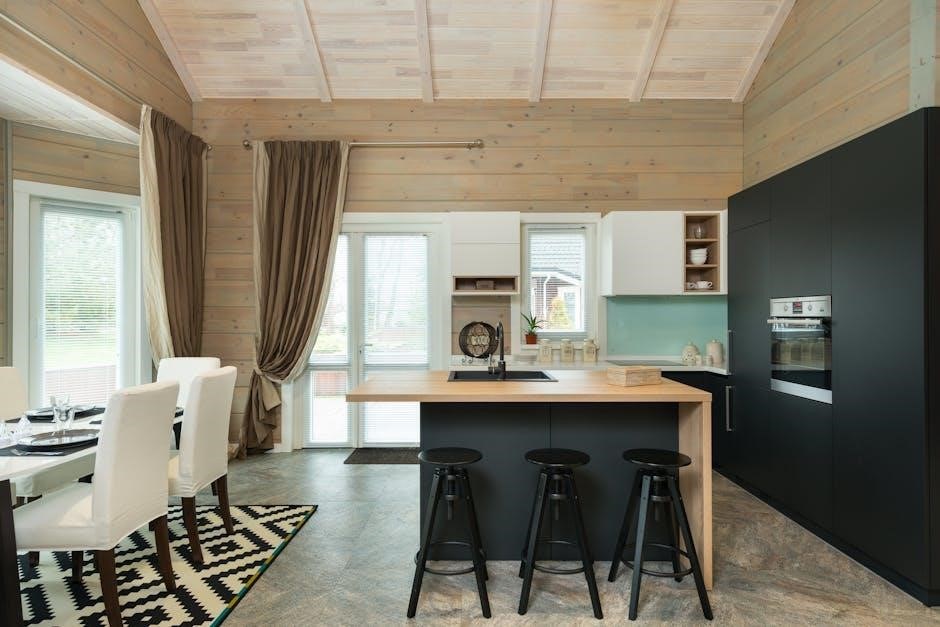
How to Measure for the Perfect Fit
To ensure the perfect fit, measure your counter height from floor to countertop․ Next, determine the ideal stool height by subtracting 10 to 12 inches for ergonomic seating․ Always consider clearance for comfortable movement․
Measuring Counter Height

Measuring counter height accurately is crucial for selecting the right stools․ Start by using a tape measure to determine the distance from the floor to the top of the countertop․ Ensure the measurement is taken squarely against the surface for accuracy․ Standard counter heights typically range between 36 and 39 inches, while bar counters are usually 40 to 42 inches․ Measure in multiple locations if the countertop is uneven or slanted to ensure consistency․ Note the exact height to avoid discrepancies․ This measurement serves as the foundation for calculating stool height and ensuring proper ergonomics․ Always double-check your measurements to confirm accuracy, as even small variations can impact comfort and functionality․ Accurate counter height measurement is the first step in achieving a seamless fit for stools or seating․
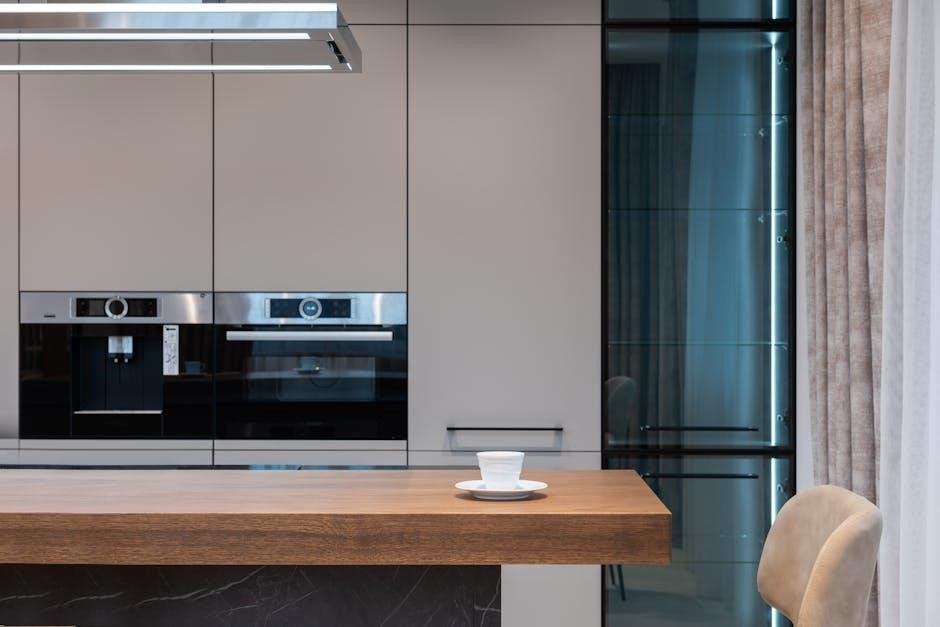
Calculating Ideal Stool Height

To determine the ideal stool height for your space, start with the counter height measurement․ A general rule of thumb is to allow 10 to 12 inches between the top of the stool seat and the countertop․ Subtract this range from the counter height to find the optimal stool height․ For example, if your counter is 36 inches tall, stools should be 24 to 26 inches high․ This ensures comfortable seating and proper ergonomics․ However, personal preference and the specific setup may require adjustments․ Always test the height if possible, as individual comfort varies․ Additionally, consider the thickness of the stool cushions, as this can affect the overall height․ Accurate calculation ensures a seamless fit and enhances the functionality of your space․ Remember, the goal is to create a comfortable and practical seating arrangement that complements your counter or bar area․

Common Mistakes to Avoid
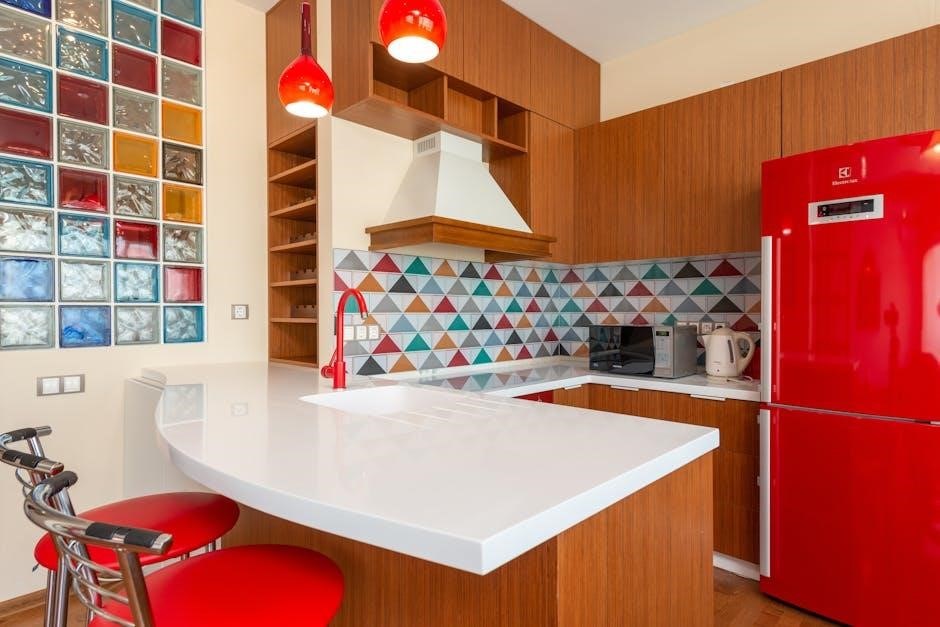
Common mistakes include incorrect measurements, ignoring clearance, and selecting stools without considering ergonomic comfort․ Proper fit ensures functionality and user satisfaction․
Incorrect Measurements
One of the most frequent errors when choosing counter stools is taking inaccurate or incomplete measurements․ Many homeowners assume standard counter heights or fail to measure the exact dimensions of their space, leading to stools that are too tall or too short․ Neglecting to account for the thickness of the countertop or the clearance needed beneath the stool can result in poor fit and functionality․ Additionally, misjudging the floor space where stools will be placed can create overcrowding or hinder movement around the counter․ To avoid these issues, it’s crucial to measure the counter height, stool height range, and available floor space accurately․ Double-checking these dimensions ensures the stools align properly with the counter and provide optimal comfort for users․ Always use a tape measure and consider multiple reference points for precise calculations․
Ignoring Clearance
Ignoring clearance is a common oversight when selecting counter stools, often leading to cramped and uncomfortable seating areas․ Clearance refers to the space between the stool, the counter, and surrounding elements, such as walls or other furniture․ Failing to account for this can result in tight spaces that hinder movement and create a claustrophobic environment․ For instance, insufficient clearance between stools and the counter edge can make it difficult to sit comfortably, while inadequate floor space can obstruct traffic flow․ Proper clearance ensures ease of access and usability․ A general rule is to allow at least 12 inches of clearance between the stool and any obstructions to maintain functionality and comfort․ Overlooking this detail can lead to a less-than-ideal seating arrangement, frustrating both users and guests․ Always prioritize measuring clearance alongside stool height to achieve a balanced setup․
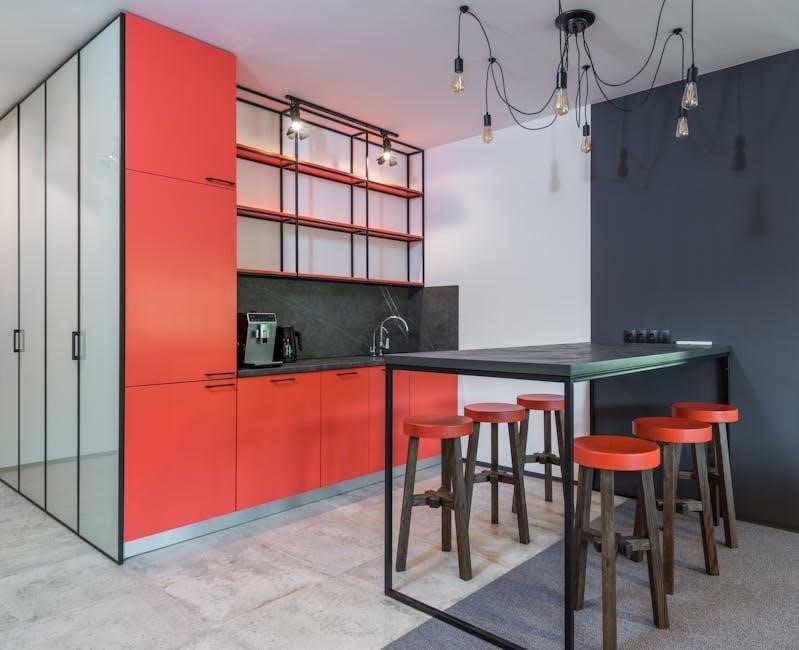
Additional Considerations
When choosing counter stools, consider seat depth, width, and backrests for comfort․ Material thickness impacts durability, while ergonomic design enhances usability․ Aesthetic factors like color and style also matter for seamless integration․
Seat Depth and Width
Seat depth and width are critical factors in ensuring comfort and functionality for counter stools․ The ideal seat depth typically ranges between 16 to 18 inches, providing ample support without causing pressure on the thighs․ Width should be proportional to the depth, generally spanning 18 to 22 inches, to accommodate various user sizes comfortably․ Ergonomics play a significant role here; a well-balanced seat depth and width promote proper posture and reduce the risk of discomfort during extended use․ Additionally, considering the space where the stools will be placed is essential to maintain adequate clearance and ease of movement․ Striking a balance between aesthetics and functionality is key, ensuring that the stools not only look appealing but also provide the necessary support and comfort․ Measuring the intended space and testing different sizes can help in making an informed decision that enhances both usability and visual harmony in the room․
Importance of Backrests
Backrests play a significant role in enhancing comfort and support for users of counter stools․ They provide essential lumbar and upper back support, reducing strain and promoting proper posture, especially for individuals who spend extended periods sitting․ A well-designed backrest can prevent fatigue and discomfort, making it a crucial feature for both short-term and long-term use․ Additionally, backrests contribute to the overall stability of the stool, offering a sense of security and balance․ When choosing backrests, consider the material, height, and adjustability to ensure they align with the user’s needs and preferences․ For taller individuals or those with back issues, a higher or adjustable backrest may be particularly beneficial․ Ultimately, backrests are not just an aesthetic element but a functional component that greatly impacts the overall comfort and usability of counter stools in various settings․
Material Thickness Impact
Material thickness significantly influences the overall dimensions and functionality of counter stools․ Thicker materials, such as solid wood or metal, can add to the stool’s height and durability but may also increase its weight and bulk․ Conversely, thinner materials, like aluminum or plastic, offer a sleeker profile and easier mobility but may lack structural rigidity․ The thickness of the seat and backrest materials also affects comfort and ergonomics, with thicker cushions providing better support․ Additionally, material thickness impacts the stool’s ability to fit under countertops, as overly thick frames may reduce clearance․ When selecting stools, it’s essential to balance material thickness with desired aesthetics, durability, and spatial requirements․ High-quality materials ensure longevity, while thinner options prioritize versatility․ Ultimately, material thickness is a critical factor in achieving the perfect blend of form and function for counter stools․